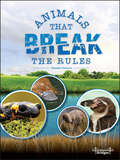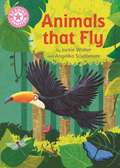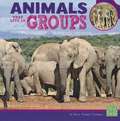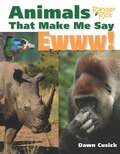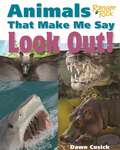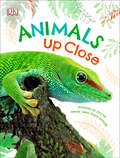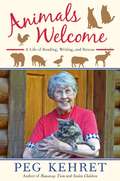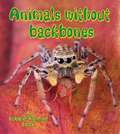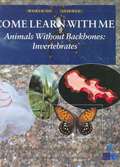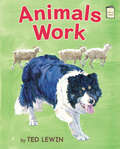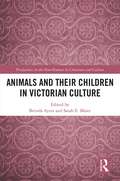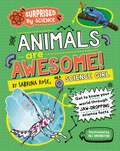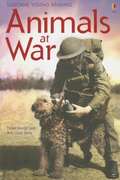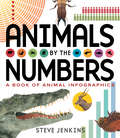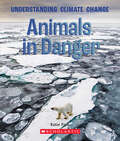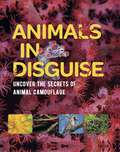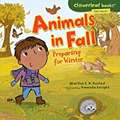- Table View
- List View
Animals That Break the Rules (Nature's Rule Breakers)
by VizcarraDid you know there are critters that are powered by the sun, mammals that lay eggs, and penguins with pink poop? What are these rule-breaking animals? Why do they do what they do? Be a critter detective and find out by digging into this Animals That Break the Rules Animal Book! Part of the Nature’s Rule Breaker’s Children’s Book Series, this 32-page nonfiction book explores strange animal species that are fascinating and fun with fun-filled facts and vibrant photos that will prove just how unique these animals really are!Science Books for Kids Ages 8-12 Features:Comprehension questionsExtension activitySupports NGSS standardsAbout Rourke Educational Media:We proudly publish respectful and relevant nonfiction and fiction titles that represent our diverse readers, and are designed to support reading on a level that has no limits!
Animals That Burrow
by Marilyn Woolley Keith PigdonMany animals shelter and raise their young in burrows. Some spend a great deal of time in their burrows.
Animals That Fly: Independent Reading Pink 1B Non-fiction (Reading Champion #515)
by Jackie WalterThis non-fiction text explores different animals that fly. The book is part of Reading Champion, a series carefully linked to book bands to encourage independent reading skills, developed with Dr Sue Bodman and Glen Franklin of UCL Institute of Education (IOE)Reading Champion offers independent reading books for children to practise and reinforce their developing reading skills.Fantastic, original stories are accompanied by engaging artwork and a reading activity. Each book has been carefully graded so that it can be matched to a child's reading ability, encouraging reading for pleasure.Perfect reads for children aged 4-5, reading at book band pink.
Animals That Hibernate
by Larry Dane BrimnerA survey of true and light-sleeping hibernators--what happens to their body processes, how they prepare for their long sleeps, and what they do when they awaken. Named to the Science Books and Films "Best Children's Science Book List, 1991". Defines hibernation and describes different animals' ways of preparing for and spending the winter. Includes bibliographical references and index.
Animals That Live In Groups
by Bernd Heinrich Kelsi Turner TjernagelWhy do millions of flamingoes flock together in Africa? Why do meerkats live in colonies? Animal groups have some fascinating behaviors. Discover the amazing bonds that keep animal groups together.
Animals That Live Under the Ground (Into Reading, Level I #61)
by Debbie CroftNIMAC-sourced textbook
Animals That Make Me Say Ewww! (Animals That Make Me Say...)
by Dawn CusickThat&’s so gross! Prepare to be grossed out by an engaging and unique look at some of the more disgusting survival techniques from the animal kingdom. From blood-squirting reptiles to blood-sweating mammals to nose-picking primates, learn about some of the most disgusting creatures in the animal kingdom. Author Dawn Cusick and the National Wildlife Federation compile a volume as attractive as its subject is disgusting.
Animals That Make Me Say Look Out! (Animals That Make Me Say...)
by Dawn CusickHey! Look out! Sharp-eyed readers will need to keep their eyes peeled in this engaging look at how animals of all shapes and sizes blend in and survive in their native ecosystems. How do animals deal with danger? From crocodiles standing on their tails to great white sharks with their jaws wide open to well-camouflaged venomous snakes, prospective naturalists and conservationists will have a lot to look out for in this exploration of dynamic ecosystems and the animals that hide and hunt in them. Back matter includes glossary, curated reading list and a scavenger hunt.
Animals Up Close: Animals as you've Never Seen them Before (DK Look Closer)
by DKGet closer to your favorite animals through amazing nature photographySee the world's most fascinating animals closer and more vividly than you've ever seen before, through stunning, larger-than-life photography in this modern DK classic.Young readers will be fascinated by stories such as the crab that carries its home on its back, or the salamander that turns from a fish into an amphibian as it grows. They will be absorbed by the incredible detail showcased in these amazing images, from the fine structure of bird's feathers to the neon green scales of a gecko. Fun, flowing text delivers in-depth information about life in different habitats and how animals have adapted to thrive in these places.Innovative, contemporary design and DK's characteristically reliable and interesting information combine in Animals Up Close to create the perfect nature book for children.
Animals Welcome: A Life of Reading, Writing, and Rescue
by Peg KehretA moving memoir from an award-winning authorA mother cat and her kittens, shot with a pellet gun. A poacher illegally stalking a bear. Peg Kehret tells these true stories and more as she invites readers into her life on a small wildlife sanctuary. Vividly showing the joys of animal rescue while providing facts about the animals and birds she encounters, Kehret also shares the tragedy of her husband's sudden death, and the pain of losing Pete, the shelter cat who co-authored three of her books. Written with honesty, heart, and humor, Animals Welcome is a personal glimpse into the life of an author who loves animals, and the philosophy by which she lives. .
Animals Without Backbones (Big Science Ideas)
by Bobbie KalmanDescribes the different kinds of invertebrates and how they function without backbones, including sponges, worms, squids, crustaceans, insects, and spiders.
Animals Without Backbones: Invertebrates
by Bridget AndersonIf you are asked to picture an animal, what comes to your mind first? A dog? A bird? Perhaps a zebra? Chances are you thought of a vertebrate, an animal with a backbone. But vertebrates, which include the animals we are most familiar with--mammals, birds, fish, reptiles, and amphibians--actually make up less than 5% of all animal species. All the rest of the animals alive today--more than 95%--are invertebrates, animals without backbones. Can you picture a spotted ladybug, spiny sea urchin, or slimy garden slug? ANIMALS WITHOUT BACKBONES: INVERTEBRATES explores the lives of the many fascinating creatures.
Animals Work (I Like to Read)
by Ted LewinAnimals herd, carry, pull, and even . . . keep us company! This nonfiction, easy-to-read picture book transports readers from an open field to a desert to a snowy tundra as animals of all kinds perform some very important work. The book ends with an endearing role reversal as a young boy gives milk to his cat, reminding readers that just as animals help people, people in turn can help animals. This book teaches readers about the variety of work animals and depicts the give-and-take of human/animal relationships. A map is included. Guided Reading Level C.
Animals and Their Children in Victorian Culture (Perspectives on the Non-Human in Literature and Culture)
by Brenda Ayres Sarah Elizabeth MaierWhether a secularized morality, biblical worldview, or unstated set of mores, the Victorian period can and always will be distinguished from those before and after for its pervasive sense of the "proper way" of thinking, speaking, doing, and acting. Animals in literature taught Victorian children how to be behave. If you are a postmodern posthumanist, you might argue, "But the animals in literature did not write their own accounts." Animal characters may be the creations of writers’ imagination, but animals did and do exist in their own right, as did and do humans. The original essays in Animals and Their Children in Victorian explore the representation of animals in children’s literature by resisting an anthropomorphized perception of them. Instead of focusing on the domestication of animals, this book analyzes how animals in literature "civilize" children, teaching them how to get along with fellow creatures—both human and nonhuman.
Animals and Their Dreams (Fountas & Pinnell Classroom, Guided Reading)
by S. E. KazarianNIMAC-sourced textbook. Sweet Dreams. People dream, but what about animals? Find out which of our animal friends dream and which ones don't.
Animals and Their Tools (Fountas & Pinnell LLI Gold #Level M)
by Joanna Solins<p>Wild Tools <p>What do a chimpanzee, an octopus, a sea otter, and a crow have in common? Like people, they all use tools to survive. Many different animals use tools to get food and stay safe-find out how! <p>Text Elements: <p> <li>Genre: Nonfiction, Expository <li>Text Structures: Main: Categorical, Embedded: Problem/Solution, Temporal Sequence, Question/ Answer, Compare/Contrast <li>Text Features: table of contents, headings, photos, captions, pronunciation guides, sidebars, map, glossary</li> </p>
Animals are Awesome! (Surprised by Science #1)
by Sabrina Rose Science GirlBe surprised by the astonishing science of the animal kingdom, with Sabrina Rose, AKA Science Girl, the internet's most inspiring curator of facts and observations of our wonderful world - making it easy for all readers to come to love science!Surprised by Science: Animals are Awesome brings an attention-grabbing and accessible set of animal facts to life! Doing what she's famous for online, Sabrina Rose dives into the most surprising corners of the animal world to explore the science at work. From adorable and unlikely friendships, to uninvited parasites; from animal impressionists to record-breaking lifespans - this series is perfect for inquisitive children age 7 and up, and all fans of Science Girl.Surprised by Science is a series of books that takes the inspiring communication and research skills of Science Girl's hugely popular platform and distills it on the page, with funny and engaging illustrations by Ali Ardington paired with photos of the real-life science in action. The series includes: Electricity is Epic!; Plants are Powerful!; Forces are Fantastic!; Sound is Sensational!; Animals are Awesome!; Human Bodies are Brilliant!
Animals at Night
by Polly PetersonDiscusses various animals which rest during daylight hours, but hunt and roam during the night.
Animals at War (Usborne Young Reading: Series Three Ser.)
by Isabel George, Rob Lloyd JonesDescribes how animals have been used in war, from Hannibal's elephants to the various animals used in the Second World War, including heroic dogs, horses, pigeons, pigs, and bears.
Animals by the Numbers: A Book of Infographics (By The Numbers Ser.)
by Steve JenkinsHow many species are there across the globe? How much do all of the insects in the world collectively weigh? How far can animals travel? Steve Jenkins answers these questions and many more with numbers, images, innovation, and authoritative science in his latest work of illustrated nonfiction. Jenkins layers his signature cut-paper illustrations alongside computer graphics and a text that is teeming with fresh, unexpected, and accurate zoological information ready for readers to easily devour. The level of scientific research paired with Jenkins’ creativity and accessible infographics is unmatched and sure to wow fans old and new.
Animals in Danger (A True Book (Relaunch))
by Katie FreeGlaciers are melting. Summers are heating up. Sea levels are on the rise. Climate change is affecting every corner of our planet - and it's the subject of a lot of concern, activism, and debate. How is climate change affecting Earth's ecosystems? What happens to animals and other organisms when the habitats around them start to change? This book addresses how climate change affects species on land and in the ocean, which species are most at risk of extinction, and why the speed at which changes are happening makes it difficult for organisms to adapt.STEM meets current events in this new A True Book set that offers readers the chance to learn about the causes and effects of climate change, as well as how people around the world are reacting to it. Students will read about the history and scope of the problem, analyze the same kinds of evidence that scientists do, and come away with tools that will help them respond to this pressing global issue.This series covers Next Generation Science Standards core ideas including Weather and Climate, Human Impacts on Earth Systems, Conservation of Energy and Energy Transfer, and Biodiversity and Humans.
Animals in Disguise
by Michael BrightDiscover the most well-disguised animals on the planet!Some animals disguise themselves to look like plants or rocks. Others disappear from view altogether as they blend in to their habitats. How do they do this?In Animals in Disguise, learn about the various ways animals hide in plain sight and why. From avoiding predators and protecting themselves to ambushing or sneaking up on prey, each animal featured in this book has an astonishing skill for keeping out of sight.With different creatures from around the world, organised by classification, this book encourages the reader to seek out each creature hiding in plain sight in the full-page photograph of the featured animal. Younger children will enjoy looking at the photos to spot the camouflaged animals. To help find them a second picture shows them clearly and all is revealed at the end of the book.Perfect for readers aged 9 and up.
Animals in Fall Preparing for Winter: Preparing For Winter (Cloverleaf Books)
by Martha E. H. RustadA boy learns how animals prepare for winter.
Animals in Orbit: Monkeynauts and Other Pioneers in Space
by Katherine Mcclade MarkoDiscusses the animals originally sent up in space as experiments, and looks at current projects being conducted on various plants and animals.
